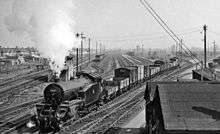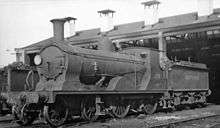Feltham marshalling yard

Feltham marshalling yard, also known as Feltham hump yard, was a large railway marshalling yard designed for the concentration of freight traffic to and from South West London, and for transfer to other marshalling yards in London. It was built on the Waterloo to Reading Line. It opened in 1918 and was closed by British Railways on 6 January 1969.
History
During the early years of the twentieth century the London and South Western Railway (LSWR) experienced a substantial growth in its freight traffic to and from London, and for transfer to other railways.[1] By 1910 this traffic was beginning to overwhelm the existing facilities at Nine Elms. Plans were therefore made for a hump marshaling yard and motive power depot at Feltham. The purchase of 41.5 acres (16.8 hectares) of land was confirmed in 1911, with additional land being purchased in 1915. This location gave excellent access to the company main lines as well as direct links to the Great Western Railway and London and North Western Railway, and to the Midland Railway, Great Northern Railway and Great Eastern Railway via the North London line. The plans were confirmed on 30 March 1916,[2] and work started soon after with the help of around 200 German prisoners of war. The first nine ‘down’ sidings were opened on 9 December 1917 and the remainder by 2 October 1921.[3]
The yard was completed in 1921 and incorporated two gravity shunting humps and equipped with the latest automated technology including electrically operated points, and widespread use of Track circuits. With its 32 miles (51 km) of track, (the longest siding being 1,662 feet or 507 metres in length and the shortest being 1,331 feet or 406 metres), it could handle 2500 wagons a day. These were brought in by 50 down and 26 up trains, and being removed by 18 down and 46 up services. This was, probably, the busiest marshalling yard in the country at that time.[4] Up to 3390 wagons could be sorted per day and an incoming train of wagons could be sorted in 12 minutes.[5]
The yard fulfilled an important part in the rail network for over four decades, especially during World War II, passing in to Southern Railway ownership in 1923 and British Railways in 1948. However, with the reduction of freight traffic carried by rail in the 1960s the yard became redundant and closed on 6 January 1969. Today,part of it is the site of the Jubilee Mail Centre, which handles work for the TW, KT, GU postcode areas as well as parts of South and West London.

Motive Power Depot
Plans for a new automated locomotive servicing depot at the marshalling yard, to replace an existing depot at Strawberry Hill (which was converted into an electric multiple unit servicing depot.[6] The shed was 475 by 125 feet (145 m × 38 m) with six roads and could accommodate 42 locomotives. There were inspection pits throughout and a 50-ton engine-hoist. There was also an electrically driven 65-foot (20 m) turntable and an electrically operated coaling plant.[7]
In 1921 Robert Urie, the Chief Mechanical Engineer of the LSWR introduced four large 4-8-0 shunting tank locomotives of the G16 class specifically to operate the yard, and five similar H16 class of 4-6-2T to undertake the transfer freight workings from Feltham. In addition the depot had a large allocation of H15 and S15 4-6-0 locomotives for heavy freight duties. The G16 and H16 locomotives were all withdrawn between 1959 and 1962, and the depot was closed by British Railways in 1967.
See also
- Aerial view of yard and motive power depot 1931 http://homepages.tesco.net/~early/lswr/004.html
- Shunter Black's Night Off, 1941 (filmed at Feltham marshalling yard) http://www.britishrailways.tv/train-videos/2012/shunter-black's-night-off-(1941)/
- The remnants of Feltham Marshalling Yards still visible in 2011 http://www.artofthestate.co.uk/rail/feltham-marshalling-yards.htm
References
- ↑ Bradley, D. L. (1967). Locomotives of the L.S.W.R. part 2. Railway Correspondence and Travel Society. p. 191.
- ↑ The National Archives - RAIL 411/271 – Traffic Committee 30/03/1916 – 507 Feltham Marshalling Sidings.
- ↑ Turner, David (9 August 2010). "The Feltham Marshalling Yard - Railway Innovation and PhD Inspiration". Retrieved 10/11/2011. Check date values in:
|access-date=(help) - ↑ Faulkner, J.N.; Williams, R.N. (1988). The LSWR in the Twentieth Century. Newton Abbot: David and Charles. pp. 127–131.
- ↑ Simmons, Jack; Biddle, Gordon, eds. (1997). "Marshalling yards". The Oxford companion to British Railway history: from 1603 to the 1990s. Oxford University Press. p. 315. ISBN 0-19-211697-5.
- ↑ Griffiths, Roger; Smith, Paul (1999). The directory of British engine sheds and principal locomotive servicing points: 1. Southern England, the Midlands, East Anglia and Wales. Oxford: Oxford Publishing Company. p. 96. ISBN 0-86093-542-6.
- ↑ Marshall, C. F. Dendy (1963). History of the Southern Railway, 2nd (revised) ed. London: Ian Allan Ltd. p. 444.
Coordinates: 51°27′N 0°23′W / 51.45°N 0.39°W